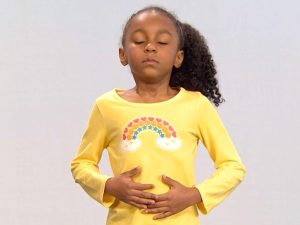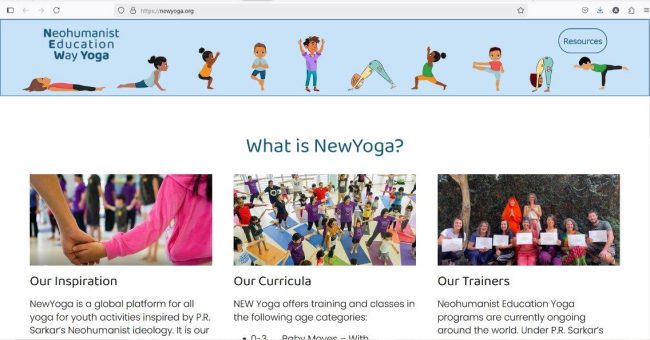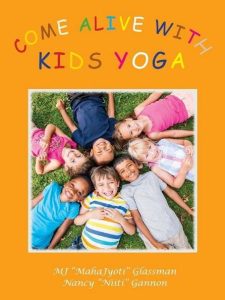By MayaJyoti Glassman
Adult Yoga Asana vs Kids Yoga Asana
Kids around the globe are faced with difficult, turbulent times. They can easily ‘get lost’ at a time when adults also find themselves challenged in this post-covid era. But yoga practitioners and teachers can offer an isle of peace, resiliency, imaginative creativity, and fun through the stabilizing practices of Astaunga Yoga.
For the young child, ‘let’s play yoga’ takes a key role. Kid friendly imaginative ‘play yoga’ is ‘taking the kid community by storm’ because this is where the child’s important brain development takes a front seat. For every decade of human development, adjustments in the expression of yoga exist and the young child is no different.
Yoga is easily ‘sculpted’ to meet the socio-emotional needs of young ones. This ancient science offers kids the opportunity to ‘try on’ different animal personalities to re-enact their behaviors, their lives, and to build connection. In this way they blend with other created beings in a play format and:
- Learn the valuable personality traits of other living beings and embrace them,
- See how the animals and plants naturally problem solve similar dilemmas,
- Experience what gifts these beings bring to Mother Earth, enriching our lives, and
- Figure out how to support these beings with food, medicine, shelter, etc.
Students are invited to create fantastic yoga variations. Kids are not restricted to one way of expressing a yoga pose.
Sometimes it is difficult for adults to make the quantum leap to embrace the steps necessary to create a kids yoga experience. However, this is an approach to yoga asana that kids can easily relate to which guarantees the optimal full participation of all children.
Kids have different needs than adults. With kids the fun and creative element is essential to optimize their participation. Physiologically speaking, one of the side-effects of this ‘fun’ factor is that it creates joy, laughter, and giggling, releasing those happy hormonal endorphins that are fundamental to mental peace.
What Kids Yoga Looks Like
With young children, what you may see in a yoga asana class is:
- ‘Dog’ kids moving around the room on all fours,
- Noisy kids making animal sounds, looking around, sniffing, pretend eating, and expressing other sensory experiences,
- Kids engaging arms and legs in activities like climbing, swimming, digging, flying,
- More theatrical expressive yoga class than adult yoga.
- It is who they are. It is where they are developmentally as human beings.
The Fullness of Yoga
The Fullness of Yoga
8 Limb Astaunga Yoga practices nurture resiliency. Kids yoga incorporates storytelling, relationship building games (non-competitive), educational factual materials, art, singing, dancing, and nature exploration. These elements can be blended into a practice at home, at school, in a community center, at a retreat, or in the park.
 Kids yoga classes are noticeably shorter than adult classes. 15 to 25 minutes long maintains their interest. However, if you are to expand this experience to include:
Kids yoga classes are noticeably shorter than adult classes. 15 to 25 minutes long maintains their interest. However, if you are to expand this experience to include:
- a best practice breathing experience,
- meditation,
- singing or chanting, and
- deep relaxation, it may be longer.
The yoga-based curriculum beyond asana practice is an essential component of neohumanist nature education. It offers an experience that is brain appropriate, social yoga ethics appropriate, a strategy for emotional regulation balance, and affecting the development or positivity and expansion of mind-body harmony.
Children feel what it is like to be a cobra, re-enact the wonderful qualities and feelings of a dog, feel the essence of being a tree, flow throughout the room like a stream, or rest like a rock. Yoga asana movements bring into the class a bridge to the world and inspires love for all created beings. These experiences enhance compassion and understanding of themselves and the world.
Other Socio-Emotional Benefits
Human beings at every age experience varying levels of hormonal secretions from those organs in the endocrine gland system. When out of balance, over- or under-secretions can produce negative thoughts, fearful feelings, and aggressive behaviors. The regular asana practice can reduce these imbalances with the pressurizing and depressurizing effects on these organs.
The regular practice of asana boosts physical, mental, and emotional fitness. Yoga experiences can maximize the desire to help others and to make better choices. Yoga and meditation strengthen the connection to the Inner Voice.
With this role-playing yoga, children relax and build positive relationships with other children. They learn new skills of how to get along with others; what friends like and do not like; strategies for overcoming fear or anxiety, depression, insecurity; and develop a plan for combating other negative states of being that threaten to hold them hostage.
Children who suffer from challenging thoughts and behaviors, or wrangle with attention deficit disorder or other differing abilities, can find comfort in a yoga asana class where emphasis is placed on calming the nervous system, focusing on the breath, feeling the physical postures in their muscles and in their hearts. Using affirmations like “I am the super friend. I take care of others” builds confidence and a more positive self-image.
The regular practice of all Astaunga Yoga practices including meditation:
- Calms the thoughts,
- Increase concentration,
- Reduces stress in the mind-body,
- Encourages positive thoughts,
- Minimizes negative thinking, and
- Supports the capacity of inner listening.
Many experts feel that when introducing children to yoga, the ages 3-8 are very ideal. These ancient and wonderful practices are still as relevant today as 7,000 years ago. Together they nurture inner peace, love, and happiness as well as supporting a calm and peaceful mind.
Let us come together. Let us move together. Let us join hands with all created beings, expressing caring and connection in our safe and beautiful yoga world.
(You may contact MahaJyoti if you are interested in other educational materials for teaching kids Astaunga Yoga Practices for Kids at: . She is the current Administrator of AMAYE, Ananda Marga Association of Yoga Educators.)
CHECK OUR NEW WEBSITE
And these books:
https://nhepublications.gurukul.edu/product-category/teaching-yoga-to-children/




